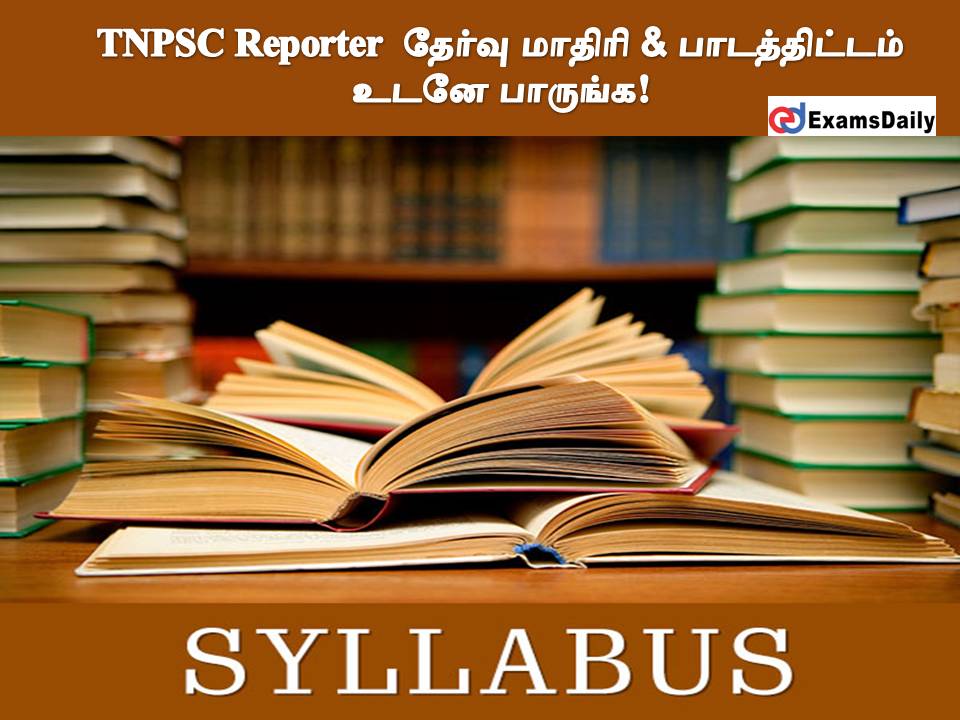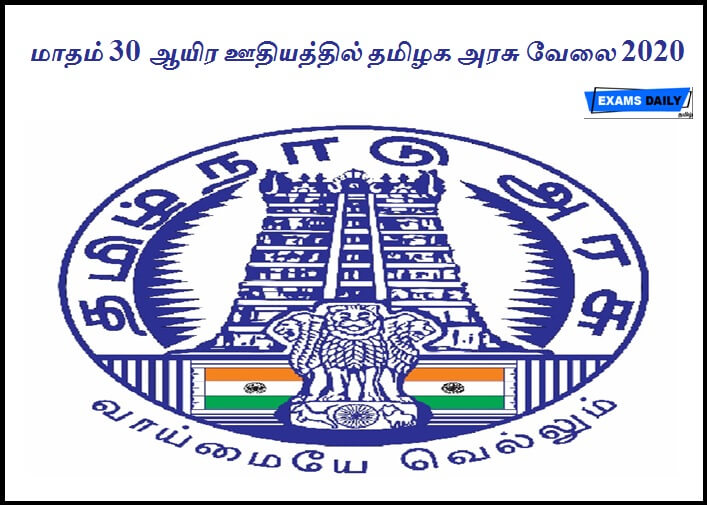TNPSC Reporter தேர்வு மாதிரி & பாடத்திட்டம் – உடனே பாருங்க!
தமிழ்நாடு அரசு பணியாளர் தேர்வு ஆணையம் ஆனது Tamil மற்றும் English Reporter ஆகிய பதவிகளுக்கான தேர்வு மாதிரி பாடத்திட்டம் இப்பதிவில் கொடுக்கப்பட்டுள்ளது.
Download Notification 2022
TNPSC தேர்வு செய்யும் முறை:
இந்த அரசு பணிக்கு விண்ணப்பிக்கும் விண்ணப்பதாரர்கள் Computer Based Test (CBT) மற்றும் நேர்முக தேர்வு மூலம் தேர்வு செய்யப்படுவார்கள்.
நாங்கள் இப்பகுதியில் எழுத்து தேர்வுக்கு தேவையான தேர்வு மாதிரி & பாடத்திட்டம் ஆகிய விவரங்களை கீழே தொகுத்து வழங்கி உள்ளோம். அதன் மூலம் தேர்வர்கள் எளிதில் தேர்வில் வெற்றி பெறலாம்.
SCHEME OF EXAMINATION: OBJECTIVE TYPE (CBT METHOD) AND ORAL TEST :
| Subject EXAMINATION in COMPUTER BASED TEST Method | Duration | Maximum Marks | Minimum qualifying marks for selection | |
| SCs, SC(A)s, STs, MBCs/ DCs, BC(OBCM)s & BCMs | Others | |||
| (i) Paper I
Subject Paper ( Diploma standard) – 100 Questions Stenography in English (Code No. 378) (or) Stenography in Tamil (Code No. 383 ) |
1 ½ Hours | 150 | 102 (For Both Paper 1 & 2) | 136 (For Both Paper 1 & 2) |
| (ii) Paper II (Total 200 questions)
Part-A Tamil Eligibility Test (SSLC Std) (100 questions/ 150 marks) |
· Note: Minimum qualifying marks –60 marks (40% of 150)
· Marks secured in Part-A of Paper-II will not be taken into account for ranking |
|||
| Part-B
(General Studies) (Code No.003) (100 questions/ 150 marks) General Studies (Degree Std) -75 questions and Aptitude & Mental Ability Test (SSLC Std.) -25 questions |
3 Hours (Together for Part A & B) | 150 | ||
| (iii) Interview and Records | 40 | |||
| Total | 340 | |||
SYLLABUS FOR EXAMINATION (CBT Method)
Paper-I
STENOGRAPHY (ENGLISH) – DIPLOMA STANDARD
SUBJECT CODE: 378
UNIT I
- Importance of Stenography
- Consonants
- Grammalogues
- Phraseography
- Circles and Loops
- Initial and Final Hooks
UNIT II
- Compound Consonants
- The Halving Principle
- The Doubling Principle
- Medial Semicircle
UNIT III
- Prefixes and Negative words
- Suffixes and Terminations
- Contractions
- Special Contractions
UNIT IV
- Advanced Phraseography
- Intersections
- Usage of Political Phrases
- Usage of Legal Phrases
UNIT V
- Note-taking and Transcription
- Legislature Reporting
- Techniques for improving Speed
Paper-I STENOGRAPHY (TAMIL) – DIPLOMA STANDARD
TNPSC Reporter Syllabus Topics:
சுருக்கெழுத்து பாடத்திட்டம் டிப்ளமோ நிலை
பாடக்குறியீடு:383
அலகு1
- சுருக்கெழுத்தின் முக்கியத்துவம்
- மெய்யெழுத்துக்கள்
- தனிகுறிச்சொற்கள்
- சொற்றொடரியல்
- வட்டங்கள் மற்றும் சுழிகள்
- ஆரம்ப மற்றும் இறுதி கொக்கிகள்
அலகு 2
- கூட்டு மெய்கள்
- பாதியாக்கும் முறை
- இரட்டிப்பு முறை
- நடு அரைவட்டம்
அலகு 3
- முன்னொட்டுகள் மற்றும் எதிர்மறை சொற்கள்
- 2 பின்னொட்டுகள் மற்றும் இறுதி வார்த்தைகள்
- சுருக்கங்கள்
- சிறப்புச் சுருக்கங்கள்
அலகு 4
- மேம்பட்ட சொற்றொடரியல்
- வெட்டும் முறை
- அரசியல் சொற்றொடர்களின் பயன்பாடு
- சட்ட சொற்றொடர்களின் பயன்பாடு
அலகு 5
- குறிப்பெடுத்தல் மற்றும் விரிவாக்கம் செய்தல்
- சட்டமன்றம்-குறிப்பெடுத்தல்
- வேகத்தை மேம்படுத்துவதற்கான நுட்பங்கள்
Paper-II SYLLABUS FOR EXAMINATION (CBT Method) PART – A
TAMIL ELIGIBILITY TEST (SSLC STANDARD)
கட்டாய தமிழ்மொழி தகுதித் தேர்விற்கான பாடத்திட்டம் (கொள்குறி வினாவிற்கான தலைப்புகள்)
பத்தாம் வகுப்பு தரம்
- பிரித்தெழுதுதல் சேர்த்தெழுதுதல்.
- எதிர்ச்சொல்லை எடுத்தெழுதுதல்.
- பொருந்தாச்சொல்லைக் கண்டறிதல்.
- பிழை திருத்தம் (i) சந்திப்பிழையை நீக்குதல் (ii) மரபுப் பிழைகள், வழுவுச் சொற்களை நீக்குதல் பிறமொழிச் சொற்களை நீக்குதல்.
- ஆங்கிலச் சொல்லுக்கு நேரான தமிழ்ச் சொல்லை அறிதல்.
- ஒலி மற்றும் பொருள் வேறுபாடறிந்து சரியான பொருளையறிதல்.
- ஒரு பொருள் தரும் பல சொற்கள்.
- வேர்ச்சொல்லைத் தேர்வு செய்தல்.
- வேர்ச்சொல்லைக் கொடுத்து வினைமுற்று. வினையெச்சம், வினையாலணையும் பெயர், தொழிற்பெயரை உருவாக்கல்.
- அகர வரிசைப்படிசொற்களை சீர் செய்தல்.
- சொற்களை ஒழுங்குப்படுத்தி சொற்றொடராக்குதல்.
- இருவினைகளின் பொருள் வேறுபாடு அறிதல். (எ.கா.) குவிந்து குவித்து
- விடைக்கேற்ற வினாவைத் தேர்ந்தெடுத்தல்
- எவ்வகை வாக்கியம் என க்கண்டெழுதுதல் – தன்வினை, பிறவினை, செய்வினை, செயப்பாட்டு வினைவாக்கியங்களைக் கண்டெழுதுதல்
- உவமையால் விளக்கப்பெறும் பொருத்தமான பொருளைத் தேர்ந்தெழுதுதல
- அலுவல்சார்ந்தசொற்கள் (கலைச்சொல்)
- விடைவகைகள்.
- பிறமொழிச் சொற்களுக்கு இணையான தமிழ்ச் சொற்களைக் கண்டறிதல் (எ.கா.) கோல்டுபிஸ்கட் தங்கக்கட்டி.
- ஊர்ப்பெயர்களின் மரூஉவை எழுதுக (எ.கா.) தஞ்சாவூர் தஞ்சை
- நிறுத்தற்குறிகளை அறிதல்.
- பேச்சு வழக்கு, எழுத்து வழக்கு (வாரான் வருகிறான்).
- சொற்களை இணைத்து புதிய சொல் உருவாக்கல்.
- பொருத்தமான காலம் அமைத்தல் (இறந்தகாலம், நிகழ்காலம், எதிர்காலம்).
- சரியான வினாச் சொல்லைத் தேர்ந்தெடு
- சரியான இணைப்புச் சொல் (எனவே, ஏனெனில், ஆகையால், அதனால், அதுபோல)
- அடைப்புக்குள் உள்ள சொல்லைத்தகுந்த இடத்தில் சேர்க்க
- இருபொருள் தருக.
- குறில் நெடில் மாற்றம், பொருள் வேறுபாட
- கூற்று. காரணம் சரியா? தவறா?
- கலைச்சொற்களை அறிதல் : எ.கா.- Artificial Intelligence- செயற்கை நுண்ணறிவு Super Computer மீத்திறன் கணினி
- பொருத்தமான பொருளைத் தெரிவு செய்தல்
- சொற்களின் கூட்டுப் பெயர்கள் (எ.கா.) புல் புற்கள்
- சரியான தொடரைத் தேர்ந்தெடுத்தல்
- பிழைதிருத்துதல் (ஒரு.ஓர்)
- சொல்-பொருள் பொருத்து
- ஒருமை பன்மை பிழை
- பத்தியிலிருந்து வினாவிற்கான சரியான விடையைத் தேர்ந்தெடு
Paper-II PART – B GENERAL STUDIES (DEGREE STANDARD)
CODE NO.003
UNIT-I: GENERAL SCIENCE
(i) Scientific Knowledge and Scientific Temper – Power of Reasoning – Rote Learning vs Conceptual Learning – Science as a tool to understand the past, present and future.
(ii) Nature of Universe – General Scientific Laws – Mechanics – Properties of Matter, Force, Motion and Energy – Everyday application of the Basic Principles of Mechanics, Electricity and Magnetism, Light, Sound, Heat, Nuclear Physics, Laser, Electronics and Communications.
(iii) Elements and Compounds, Acids, Bases, Salts, Petroleum Products, Fertilisers, Pesticides.
(iv) Main concepts of Life Science, Classification of Living Organisms, Evolution, Genetics, Physiology, Nutrition, Health and Hygiene, Human Diseases.
(v) Environment and Ecology.
UNIT-II: CURRENT EVENTS
(i) History – Latest diary of events – National symbols – Profile of States – Eminent personalities and places in news – Sports-Books and authors.
(ii) Polity – Political parties and political system in India-Public awareness and General administration- Welfare oriented Government schemes and their utility, Problems in Public Delivery Systems.
(iii) Geography-Geographical landmarks.
(iv) Economics-Current socio-economic issues.
(v) Science-Latest inventions in Science and Technology.
(vi) Prominent Personalities in various spheres – Arts, Science, Literature and Philosophy.
UNIT-III: GEOGRAPHY OF INDIA
(i) Location – Physical features – Monsoon, Rainfall, Weather and Climate – Water Resources – Rivers in India – Soil, Minerals and Natural Resources – Forest and Wildlife – Agricultural pattern.
(ii) Transport -Communication.
(iii) Social Geography – Population density and distribution- Racial, Linguistic Groups and Major Tribes.
(iv) Natural calamity – Disaster Management – Environmental pollution: Reasons and preventive measures – Climate change – Green energy.
UNIT–IV: HISTORY AND CULTURE OF INDIA
(i) Indus Valley Civilization – Guptas, Delhi Sultans, Mughals and Marathas – Age of Vijayanagaram and Bahmani Kingdoms – South Indian History.
(ii) Change and Continuity in the Socio – Cultural History of India.
(iii) Characteristics of Indian Culture, Unity in Diversity –Race, Language, Custom.
(iv) India as a Secular State, Social Harmony.
UNIT-V: INDIAN POLITY
(i) Constitution of India – Preamble to the Constitution- Salient features of the Constitution- Union, State and Union Territory.
(ii) Citizenship, Fundamental Rights, Fundamental Duties, Directive Principles of State Policy.
(iii) Union Executive, Union Legislature – State Executive, State Legislature – Local Governments, Panchayat Raj.
(iv) Spirit of Federalism: Centre-State Relationships.
(v) Election – Judiciary in India – Rule of Law.
(vi) Corruption in Public Life – Anti-corruption measures – Lokpal and Lok Ayukta – Right to Information- Empowerment of Women-Consumer Protection Forums, Human Rights Charter.
UNIT-VI: INDIAN ECONOMY
(i) Nature of Indian Economy – Five year plan models – an assessment – Planning Commission and Niti Ayog.
(ii) Sources of revenue – Reserve Bank of India – Fiscal Policy and Monetary Policy – Finance Commission – Resource sharing between Union and State Governments – Goods and Services Tax.
(iii) Structure of Indian Economy and Employment Generation, Land Reforms and Agriculture – Application of Science and Technology in Agriculture – Industrial growth – Rural Welfare Oriented Programmes – Social Problems – Population, Education, Health, Employment, Poverty.
UNIT-VII: INDIAN NATIONAL MOVEMENT
(i) National Renaissance –Early uprising against British rule – Indian National Congress – Emergence of leaders –B.R.Ambedkar, Bhagat Singh, Bharathiar, V.O. Chidambaranar Jawaharlal Nehru, Kamarajar, Mahatma Gandhi, Maulana Abul Kalam Azad, Thanthai Periyar, Rajaji, Subash Chandra Bose, Rabindranath Tagore and others.
(ii) Different modes of Agitation: Growth of Satyagraha and Militant Movements.
(iii) Communalism and Partition.
UNIT-VIII: History, Culture, Heritage and Socio-Political Movements in Tamil Nadu
(i) History of Tamil Society, related Archaeological discoveries, Tamil Literature from Sangam Age till contemporary times.
(ii) Thirukkural :
(a) Significance as a Secular Literature
(b) Relevance to Everyday Life
(c) Impact of Thirukkural on Humanity
(d) Thirukkural and Universal Values – Equality, Humanism, etc
(e) Relevance to Socio-Politico-Economic affairs
(f) Philosophical content in Thirukkural
(iii) Role of Tamil Nadu in freedom struggle – Early agitations against British Rule – Role of women in freedom struggle.
(iv) Evolution of 19th and 20th Century Socio – Political Movements in Tamil Nadu – Justice Party, Growth of Rationalism – Self Respect Movement, Dravidian Movement and Principles underlying both these Movements, Contributions of Thanthai Periyar and Perarignar Anna.
UNIT–IX: Development Administration in Tamil Nadu
(i) Human Development Indicators in Tamil Nadu and a comparative assessment across the Country – Impact of Social Reform Movements in the Socio – Economic Development of Tamil Nadu.
(ii) Political parties and Welfare schemes for various sections of people – Rationale behind Reservation Policy and access to Social Resources Economic trends in Tamil Nadu – Role and impact of social welfare schemes in the Socio-Economic Development of Tamil Nadu.
(iii) Social Justice and Social Harmony as the Cornerstones of SocioEconomic Development.
(iv) Education and Health Systems in Tamil Nadu.
(v) Geography of Tamil Nadu and its impact on Economic growth.
(vi) Achievements of Tamil Nadu in various fields.
(vii) e-Governance in Tamil Nadu.
UNIT-X: APTITUDE AND MENTAL ABILITY
(i) Simplification – Percentage – Highest Common Factor (HCF) – Lowest Common Multiple (LCM).
(ii) Ratio and Proportion.
(iii) Simple interest – Compound interest – Area – Volume – Time and Work.
(iv) Logical Reasoning – Puzzles-Dice – Visual Reasoning – Alpha numeric Reasoning – Number Series.
Download TNPSC Reporter Syllabus 2022 PDF
Official Website
To Subscribe => Youtube Channel கிளிக் செய்யவும்
To Join => Whatsapp கிளிக் செய்யவும்
To Join => Facebook கிளக் செய்யவும்
To Join => Telegram Channel கிளிக் செய்யவும்







